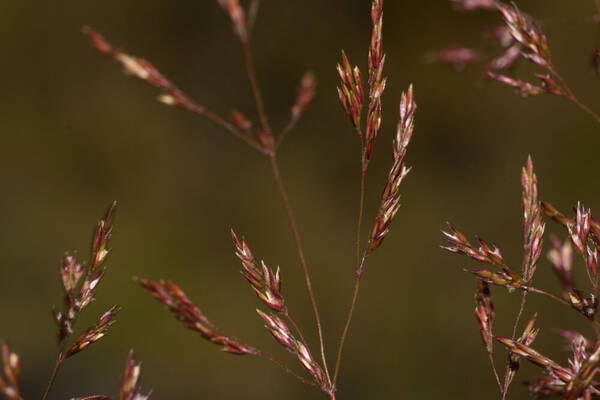Info
Subfamily: Pooideae
Genus etymology: Agrostis the ancient Greek name for herbacous plants in general, literallly "field / pasture". Its later use in plant names is reserved for grasses and there are many grass genera suffixed with Agrostis
Species etymology: stolonifera = "stolon bearing" [Latin] refering to presence of stolons
Photosynthetic type: C3 (cool season)
Nativity: naturalized - intentional
First recorded in Hawaiʻi: 1912
Map

Inflorescence





Habit

Spikelets



Collar

Description
Plants perennial; stoloniferous, stolons 5-100+ cm, rooting at the nodes, often forming a dense mat, without rhizomes. Culms (8)15-60 cm, erect from a geniculate base, sometimes rooting at the lower nodes, with (2)4-7 nodes. Leaves mostly cauline; sheaths smooth; ligules longer than wide, dorsal surfaces usually scabrous, rarely smooth, apices usually rounded, acute to truncate, erose to lacerate, basal ligules 0.7-4 mm, upper ligules 3-7.5 mm; blades 2-10 cm long, 2-6 mm wide, flat. Panicles (3)4-20 cm long, less than 1/2 the length of the culm, 0.5-3(6) cm wide, narrowly contracted, dense, oblong to lanceolate, exserted from the sheaths at maturity, lowest node with 1-7 branches; branches scabrous, ascending to appressed, except briefly spreading during anthesis, usually some branches at each node spikelet-bearing to the base, lower branches 2-6 cm; pedicels 0.3-3.3 mm. Spikelets lanceolate, green and slightly to strongly suffused with purple. Glumes subequal to unequal, 1.6-3 mm, lanceolate, 1-veined, sometimes scabridulous distally, at least on the midvein, acute to acuminate or apiculate; callus hairs to 0.5 mm, sparse; lemmas 1.4-2 mm, opaque to translucent, smooth, 5-veined, veins obscure or prominent distally, apices acute to obtuse, entire or the veins excurrent to about 0.1 mm, usually unawned, rarely with a subapical straight awn to about 1 mm; paleas 0.7-1.4 mm, veins visible; anthers 3, 0.9-1.4 mm. Caryopses 0.9-1.3 mm; endosperm solid. 2n = 28, 35,42.
(Description source: Barkworth, M.E., Capels, K.M. & Long, S. (eds.) 1993. Flora of North America, north of Mexico. Volume 24. Magnoliophyta: Commelinidae (in part): Poaceae, Part 1. Oxford University Press, New York. 911 pp. http://floranorthamerica.org/Agrostis_stolonifera )
Rhizomatous or stoloniferous perennials; culms decumbent, (3-)4-10(-13) dm long. Sheaths smooth, glabrous, persistent; ligule truncate to obtuse, 1.5-5(-8.5) mm long, erose-ciliolate, often lacerate; blades flat, folded, or involute, relatively wide, 2- 5(-6) mm wide when opened, scabrous. Panicles (7-)10-18(-25) cm long, open, sometimes closing after anthesis, the branches scabrous, verticillate, ascending, floriferous from base; glumes lanceolate, acute, rounded on the back, nerves scabrous, purplish, first glume 2-2.5 mm long, second glume 1.8-2.2(-2.5) mm long; lemma membranous, 1.4-1.8(-2.3) mm long, 3-5-nerved, awnless, callus minutely bearded; palea membranous, translucent, 0.7-1.5 mm long. Caryopsis pale brown to reddish brown, 0.5-0.8 mm long. [2n = 28- 30, 32, 35, 42, 44, 46.]
(Description source: O’Connor, P.J. 1990. Poaceae, pp. 1481–1604. In: Wagner W.L., Herbst D.R. & Sohmer S.H. (eds.)., Manual of the flowering plant of Hawaiʻi. Vol. 2. University of Hawaii Press & Bishop Museum Press, Honolulu )